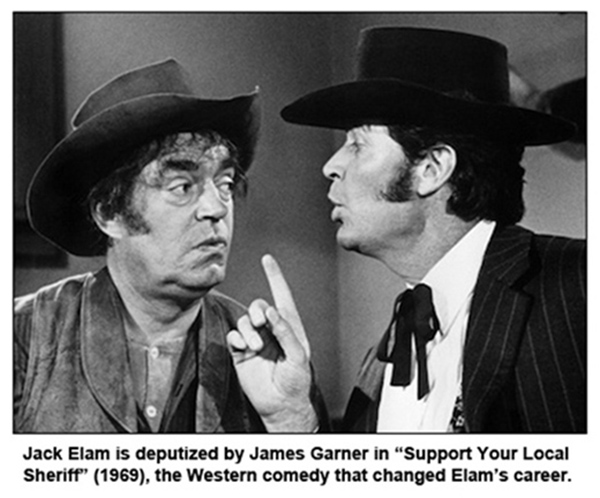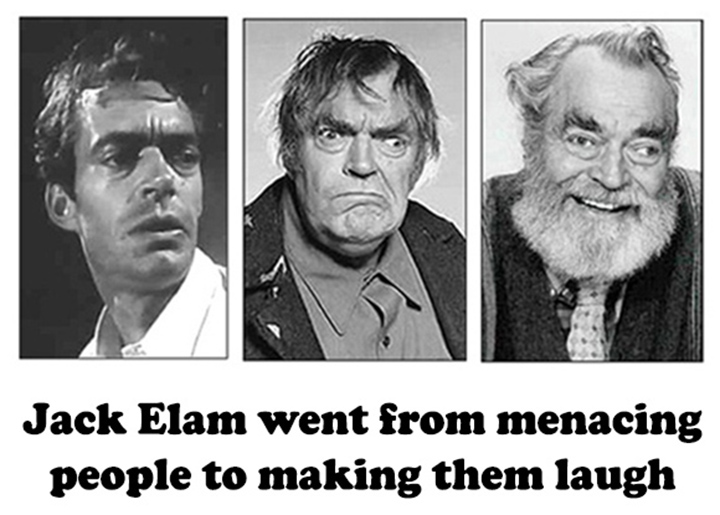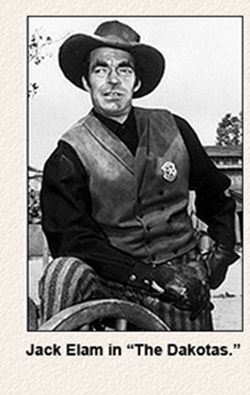| HOME |
 |
|
|
William Scott "Jack" Elam didn't set out to become an actor, but when he did it seemed likely he would always play villains. He had that kind of face. And there was something weird about his eyes. He played characters you knew would be gunned down, sometimes within minutes. In 1963 ABC-TV went ahead with a Western series that dared to do what no movie or television program had ever done before — turn Jack Elam into a good guy, a lawman on a series called "The Dakotas." That was the reason I talked to Elam in a phone interview that was conducted in May, a few days before it was announced that "The Dakotas" would not return in the fall. Little did anyone suspect that six years later, Elam's career would take a completely unexpected turn toward comedy when he worked with James Garner in "Support Your Local Sheriff." Two years after that, in 1971, Elam and Garner teamed again in "Support Your Local Gunfighter," and the dye was cast. Part of the reason is that, as he aged, Elam (above) looked less like a villain and more like the town character, the way he was perceived at the start of "Support Your Local Sheriff." And the older he got, the goofier he became. But this was not apparent when we talked in 1963 and he described his first 15 years or so as an actor who specialized in playing characters that audiences loved to hate: |
|
|
|
 |
|
Phone interviews don't delve deep into their subjects. Also, in 1963 we lacked the research tools that are available now on-line. Jack Elam did not mention, for example, that he did some film acting as early as 1944 in a short Western called "Trailin' West," directed by his friend, George Templeton. He also appeared in a 1947 Western, "Mystery Range," with Lee "Lasses" White. He did turn to acting for good in "The Sundowners," directed by George Templeton and starring Robert Preston. It was released in 1950. That same year he was in "High Lonesome," produced by Templeton and starring John Drew Barrymore. I couldn't find the final movie in that three-movie deal Elam mentioned. Most of the biographical information about Elam says he did not turn to acting on a whim, but because his job as auditor threatened his eyesight. It seems that as a youngster Elam suffered an injury to his left eye. There is no mention that he was blinded in that eye, just that it no longer functioned properly. One source says the eye was fixed, always staring ahead; another source says it turned to the left, regardless of where Elam was looking out of his good right eye. He was quoted as saying he had no control over his left eye. "It just does what it damn well pleases." His auditing job reportedly was putting a strain on his good eye, and he was advised to find another profession. In choosing acting, Elam found work that put his eyes to good use. Both eyes also had a tendency to bulge. In short, Elam had a perfect face for certain kinds of roles. He followed up his two James Garner Westerns with several comedies, including a gem of a TV series that was canceled before it could find an audience. It was "The Texas Wheelers," about a weird single father who tries to raise four sons. Co-stars included Gary Busey and Mark Hamill. The show ran only eight episodes. Elam also played Kid Sheleen, the character created by Lee Marvin in the 1965 Oscar winner "Cat Ballou." Elam starred in a 1971 TV version. Elam kept working until 1995. His last appearances were in the TV movie, "Bonanza: Under Attack" and "Lonesome Dove: The Series." His first wife died in January, 1961. Later that year he married Margaret Jennison and they remained married until his death in October, 2003. Elam had two daughters, Jeri and Jacqueline, and a son, Scott, who did some acting a few years ago. His career was unusual, to say the least. And as good as he thought he had it when we talked in 1963, I have a feeling that Elam was astonished at how much better his career would become when the audience stopped hissing him and started laughing. |
|
| HOME • STARSTRUCK • CONTACT |

 one, probably because he began his adult life as an auditor, working in Hollywood. In 1949, without prior experience, he decided to go into acting.
one, probably because he began his adult life as an auditor, working in Hollywood. In 1949, without prior experience, he decided to go into acting.